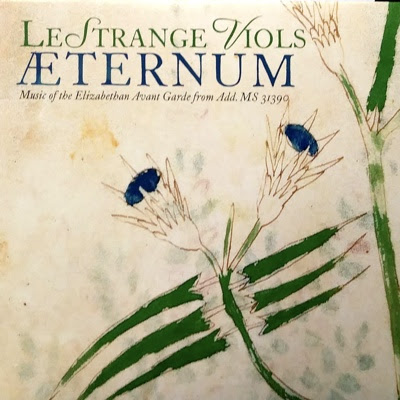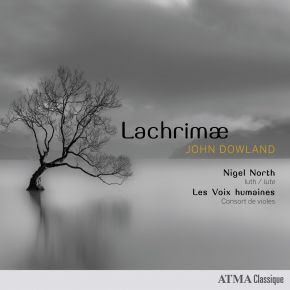Program: #18-32 Air Date: Jul 30, 2018
To listen to this show, you must first LOG IN. If you have already logged in, but you are still seeing this message, please SUBSCRIBE or UPGRADE your subscriber level today.
John Dowland in consort, William Byrd and John Bull, and a look at the “Elizabethan Avant Garde."
I. Aeternum: Music of the Elizabethan Avant Garde (LeStrange Viols). Olde Focus CD FCR912.

From Early Music America: LeStrange Viols is a relatively new ensemble, having come together in 2014 to record their debut album, a modern premiere of eclectic, experimental consort music by the 17th-century composer William Cranford. While that album focused on the music of a single composer, here they explore the consort works notated within a single manuscript: London, British Library, Add. MS 31390. Entitled “A Booke of In Nomines and Other Solfainge Songs of V, VI, VII, & VIII Pts for Voyces or Instrumentes,” it contains more than 135 compositions copied in the mid- to late 16th century. The pieces range from (largely untexted) Magnificats, motets, and anthems to French, Italian, and English secular music and more than 60 instrumental works. It is clear that the manuscript was meant to be performed from, because it is notated in table-book format: each part is copied facing a different direction, such that the singers or players could sit around a table and see just their own part.LeStrange chose 26 of the manuscript’s works to record here. As they state, some of these were the “hottest” new pieces of their day, like those by newcomer William Byrd, while other works were the “golden oldies”: particular favorites from earlier in the 16th century, such as those by John Taverner or John Sheppard. Regardless of date, however, the pieces reflect a conglomeration of styles, textures, and techniques. Some are simple, singable, and popular in style, like the French chansons by Janequin and Clemens non Papa. Others are reminiscent of the Cranford album in their rhythmic and harmonic complexities; listen, for example, to the setting of Spes nostra by Osbert Parsley, which has a five-beat cantus firmus, or the In nomine by Picforth, in which each instrument plays only one type of rhythmic value throughout.
Peppered throughout are the delightful English cross-relations, and LeStrange doesn’t shy away from accentuating them, adding a delicious crunch to many of these works. In fact, they don’t shy away from much; they play with attention to dynamics and a lovely sense of phrase, each voice swelling and fading according to its own structure but always with a careful ear toward group cohesion and overall rhetorical gesture. They’re not afraid to have fun, though; the Picforth is delightful here with the cantus firmus bowed and all other voices plucking, and Christopher Tye’s setting of the In nomine ‘Crye’ is taken at a peppy tempo, allowing the various “cryes” to bounce frenetically from player to player.
As befits the manuscript’s title, a good third of the album is settings of the In nomine, but they are wonderfully interspersed among a variety of other types of pieces. Particular standouts are the album’s opening In Aeternum by William Mundy, Byrd’s O salutaris hostia, and the setting of Browning my dere by Clement Woodcock (perhaps the manuscript’s scribe); so too are the Clemens non Papa chanson and the Taverner In nomine, which have si placet voices unique to this manuscript. This is an album that would be highly recommended simply for paying unique and careful attention to works in their original context. Fortunately, LeStrange lives up to the promise of their first album, treating us to a fascinating musical experience as well.
| 01 |
In Æternum a6
|
4:37 | ||
| 02 | In nomine a5 |
In nomine a5
|
1:42 | |
| 03 | Quemadmodum a6 |
Quemadmodum a6
|
5:19 | |
| 04 | A Phancy a5 |
A Phancy a5
|
1:58 | |
| 05 | In nomine a6 |
In nomine a6
|
3:53 | |
| 06 | Esperants a5 |
Esperants a5
|
1:50 | |
| 07 | In nomine #1 a7 |
In nomine #1 a7
|
2:30 | |
| 08 | In nomine #2 a7 |
In nomine #2 a7
|
3:04 | |
| 09 | In nomine 'Crye' a5 |
In nomine 'Crye' a5
|
1:37 | |
| 10 | O salutaris hostia a6 |
O salutaris hostia a6
|
2:37 | |
| 11 | Yf man in care a6 |
Yf man in care a6
|
1:45 | |
| 12 | Lawdes Deo a5 |
Lawdes Deo a5
|
2:28 | |
| 13 | In nomine #1 a5 |
In nomine #1 a5
|
1:46 | |
| 14 | Qual iniqua mia sorte a5 |
Qual iniqua mia sorte a5
|
2:49 | |
| 15 | In nomine a4 |
In nomine a4
|
1:43 | |
| 16 | O lux beata Trinitas a5 |
O lux beata Trinitas a5
|
2:44 | |
| 17 | Or vien ca, vien, m'amye a5 |
Or vien ca, vien, m'amye a5
|
1:34 | |
| 18 | Spes nostra a5 |
Spes nostra a5
|
2:19 | |
| 19 | Dum transisset Sabbatum a6 |
Dum transisset Sabbatum a6
|
3:34 | |
| 20 | Browning my dere a5 |
Browning my dere a5
|
2:13 | |
| 21 | In nomine a5 |
In nomine a5
|
2:08 | |
| 22 | Frisque et gaillard a5 |
Frisque et gaillard a5
|
2:12 | |
| 23 | O sacrum convivium a5 |
O sacrum convivium a5
|
3:23 | |
| 24 | In nomine #3 a5 |
In nomine #3 a5
|
2:16 | |
| 25 | Si de beaucoup a5 |
Si de beaucoup a5
|
1:20 | |
| 26 | Meli Bavari a6 |
Meli Bavari a6
|
2:36 |
II. Parthenia (Catalina Vicens, harpsichord & virginals/Rebeka Ruso, viols). Carpe Diem CD 16298.

The Chilenian harpsichordist Catalina Vicens celebrates the 400-year anniversary of this unique edition of English renaissance keyboard music on her debut album. To make this already diverse collection even more colorful, she uses not less than six different instruments, 3 of which are 17th c. originals. Enjoy this delicate boquet of early keyboard pieces played on virginals, harpsichords, spinettino and Muselaar, just as the royal couple may have enjoyed it for relaxation and amusement in good company.
I hope it will. Vicens’s playing is unhurried, even in galliards, but she maintains the music’s spring and momentum through eloquently spread chords and rhythmic inflections; her timing of the tumbling flourishes that climax certain sections brings both controlled and effective releases of tension. And if you sense that her sympathies lie more with the richness and mellowness of Byrd and Gibbons than with the fidgety virtuosity of Bull, her fingers are certainly up to the task of carrying off Bull’s excitable passagework, the only hint of discomfort coming in the rampant left-hand semiquaver patterns of the St Thomas Wake Galliard.
The sound of this CD is also a treat. Vicens uses no fewer than six different original instruments or copies from the Neumeyer-Junghanns-Tracey Collection in Bad Krozingen, including a sparkily metallic Ruckers harpsichord, a sweetly bell-like Ruckers double-virginal (though its rattly ‘arpichordum’ stop is brought to bear in the disc’s final track) and a delectable little Italian 4ft ‘spinettino’. Two of the Gibbons pieces are performed in the scoring with viol ad lib proposed in a later edition, but although Rebeka Rusò adds her own fine musicianship to the mix, this is ultimately Vicens’s project, and a worthy one too.
III. Lachrimae: John Dowland (Nigel North, lute/Les Voix humaines). Atma CD ACD2 2761.

Replete with many musical effects, dissonances and suspensions, the same melancholic subjects reappear throughout Dowland’s compositions: the agonies of the soul, night, and darkness. This “tear” motif first appeared in the pavan Lachrimae for lute and served as the basis for seven “passionate” pavans in the 1604 collection recorded on this new album.
-
1 Captaine Piper his Galiard 02:56
-
2 Lachrimæ Antiquæ 04:40
-
3 Coranto Were every thought an eye 01:45
-
4 The Earle of Essex Galiard 02:04
-
5 Lachrimæ Antiquæ Novæ 04:10
-
6 M. Henry Noell his Galiard 02:02
-
7 Lachrimæ Gementes 03:50
-
8 M. John Langtons Pavan 04:06
-
9 M. George Whitehead his Almand 02:25
-
10 Lachrimæ Tristes 05:01
-
11 Dowland’s Adew for Master Oliver Cromwell 04:10
-
12 Lachrimæ Coactæ 04:03
-
13 Lachrimæ Pavan pour luth 04:32
-
14 Galiard to Lachrimæ, pour luth 02:54
-
15 Lachrimæ Amantis 04:22
-
16 Sir John Souch his Galiard 01:27
-
17 Lachrimæ Veræ 04:35
Composer Info
William Mundy, Picforth, John Taverner, Edward Blankes, Philip Van Wilder, Robert Parsons, Christopher Tye, William Byrd (c.1540-1623), Mallorie, Jacquet de Berchem, Brewster, Clément Janequin, Osbert Parsley, John Sheppard, Clement Woodcock, Jacobus Clemens non Papa, Thomas Tallis, Nicholas Strogers, Philip Van Wilder, Giovanni Croce, Dr. John Bull (c.1562-1628), Orlando Gibbons (c.1583-1625), John Dowland ,
CD Info
CD FCR912, Carpe Diem CD 16298, CD ACD2 2761.